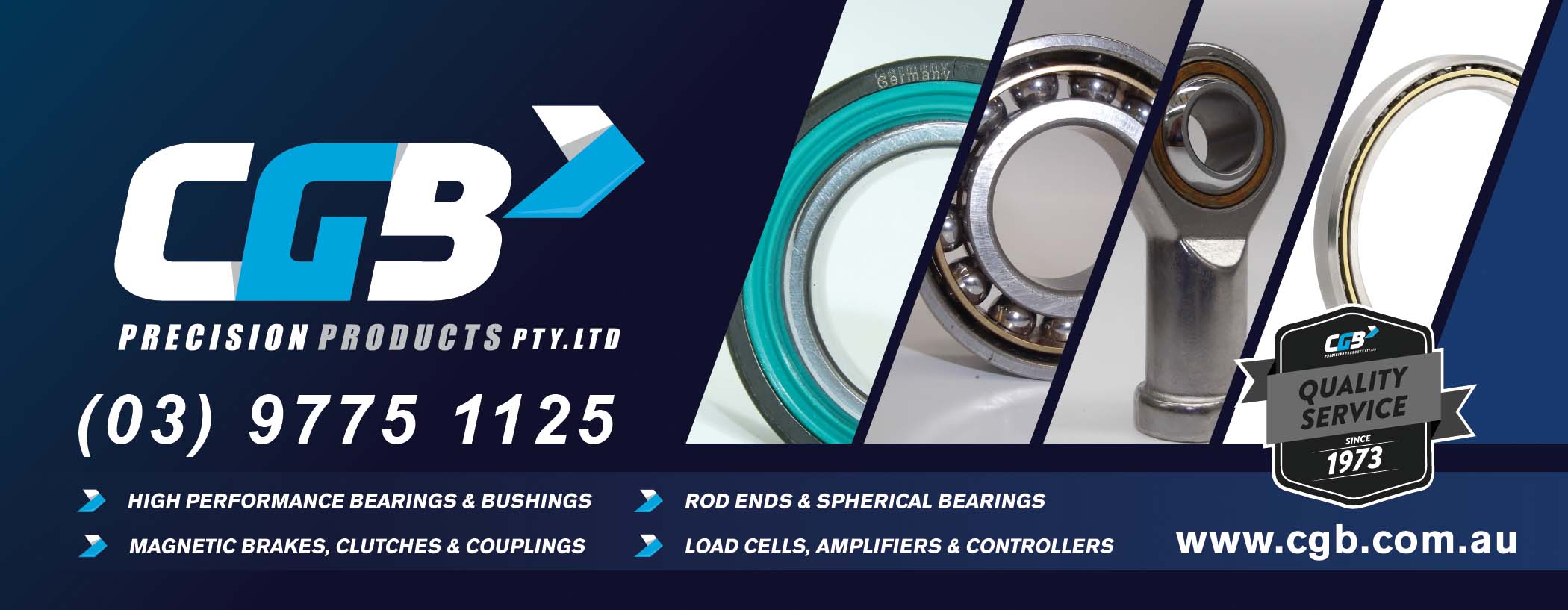
- About
- Applications
- Angular Contact
- Deep Groove
- Precision Miniature
- Specialty Bearings
- Bearing Components
- Literature
Barden Super Precision Bearings

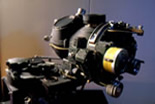 Founded by Theodore Barth and Carl Norden (hence the name "Bar-den") in 1942, the Barden Corporation was created to make precision ball bearings for the Norden bombsight, a device used by bomber aircraft to assist in accurately dropping bombs on a ground target. Each bombsight utilised over sixty superior quality ball bearings which were manufactured to tolerances beyond the scope of technology available at the time.
Founded by Theodore Barth and Carl Norden (hence the name "Bar-den") in 1942, the Barden Corporation was created to make precision ball bearings for the Norden bombsight, a device used by bomber aircraft to assist in accurately dropping bombs on a ground target. Each bombsight utilised over sixty superior quality ball bearings which were manufactured to tolerances beyond the scope of technology available at the time.
Today Barden/FAG is the preeminent leader in both the design and manufacture of super precision ball bearings. Barden bearings are produced using advanced technology to the highest standards available. That's why their bearings are used in virtually every sector of industry where there is a need to meet critical tolerances, high speeds and reliable performance under the most demanding operating conditions. Barden super precision bearings excel in applications where bearings of lesser quality have failed. If superior accuracy, reliability of operation, long-life, high running speeds and low noise and vibration are requirements in your application, Barden/FAG precision bearings are the bearings of choice.

Applications

Barden super precision bearings are used wherever the need to meet critical tolerances, high speeds and performance under demanding operating conditions are required. Because they exceed ABEC tolerances, Barden bearings offer long life and reliable performance.
Machine Tool:
|
 |
 |
Aircraft:
|
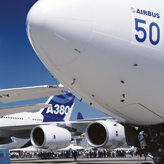 |
 |
Specialty Equipment:
|
 |
 |
Medical:
|
 |
 |
Barden Angular Contact Bearings

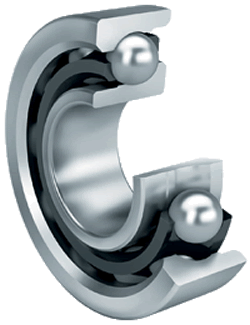 Angular contact bearings in ABEC 7 (P4S) quality from Barden and FAG. These high speed super precision bearings are available with fibre cages, ceramic and small balls, or sealed.
Angular contact bearings in ABEC 7 (P4S) quality from Barden and FAG. These high speed super precision bearings are available with fibre cages, ceramic and small balls, or sealed.
Angular contact bearings have one ring shoulder removed, either from the inner or outer ring. This allows a larger ball complement than is found in comparable deep groove bearings, giving a greater load capacity. Speed capacity is also greater.
Barden's angular contact bearings have a nominal contact angle ranging from 10° to 25°. they can be used in pre-loaded duplex sets, back to back (DB), face to face (DF) for supporting thrust loads in both directions, or in tandem (DT) for additional capacity.
Angular contact bearings support thrust loads or combinations of radial and thrust loading. They cannot accept radial loads alone. A single angular contact bearing can be loaded in one thrust direction only, this may be an operating load or pre-load.
Separable and non-separable types are both available. Separable bearings are useful where bearings must be installed in blind holes or where press fits are required on the shaft and in the housing. The separable feature also permits dynamic balancing of the rotating components with the inner ring mounted in place without the outer ring and housing
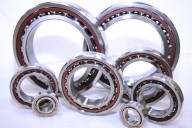
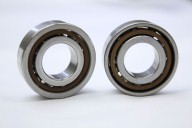
Ball Screw Support Bearings
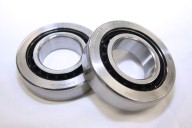 Series L ball screw support bearings are specially designed for machine tool applications. Contact angle is high at 65° to provide axial rigidity and the very high thrust capacity.
Series L ball screw support bearings are specially designed for machine tool applications. Contact angle is high at 65° to provide axial rigidity and the very high thrust capacity.
Also available are the 7602.., 7603.. and BSB (15 mm width) series.
Barden Deep Groove Bearings

 Deep groove ball bearings available from Barden and FAG in ABEC 7 (P4S) quality with high speed fibre, steel or plastic cages, ceramic balls, sealed and shielded.
Deep groove ball bearings available from Barden and FAG in ABEC 7 (P4S) quality with high speed fibre, steel or plastic cages, ceramic balls, sealed and shielded.
Deep groove ball bearings have full shoulders on both sides of the raceways of the inner and outer rings and can accept radial loads, thrust loads in either direction, or a combination of loads.
Features:
- Cages - The standard cage is a two-piece steel ribbon type. Most sizes are available with a two-piece riveted phenolic, aluminium-reinforced type. Some sizes are available with a one-piece filled nylon snap-in type. Other options may be available.
- Closures - Most bearings are available in shielded and sealed versions.
- Lubricant - Lubrication can be specified by the customer or recommended by Barden, based on the torque, speed and temperature conditions of the application.
- Loads - Deep groove ball bearings can accept radial loads, thrust loads in either direction, or combinations of loads.
- Duplexing - They can be supplied in matched pairs for duplex DB, DF or DT mounting.

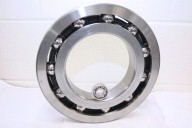
Barden Miniature Angular Contact and Deep Groove Instrument Bearings

Angular Contact Instrument Bearings
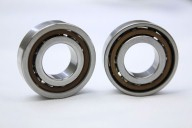 Angular contact bearings have one ring shoulder partially or totally removed. This allows a larger ball complement than found in comparable deep groove bearings, hence a greater load capacity. Speed capability is also greater.
Angular contact bearings have one ring shoulder partially or totally removed. This allows a larger ball complement than found in comparable deep groove bearings, hence a greater load capacity. Speed capability is also greater.
Angular contact bearings are assembled to a contact angle by varying the radial clearance. Instrument angular contact bearings have nominal contact angles of either 10° or 15°.
Separable and nonseparable types are available. In a separable bearing (B type), the cage holds the balls in place so that the outer ring assembly (with cage and balls) can be separated from the inner ring.
Separable bearings are useful where bearings must be installed in blind holes or where press fits are required, both on the shaft and in the housing. The separable feature also permits dynamic balancing of a rotating component with inner ring mounted in place, apart from the outer ring and housing.
Angular contact bearings support thrust loads or combinations of radial and thrust loading. They cannot accept radial loads only — a thrust load of sufficient magnitude must be present. An individual angular contact bearing can be thrust-loaded in only one direction; this load may be a working load or a preload.
Deep Groove Instrument Bearings
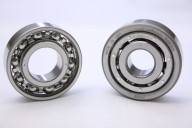 Deep groove ball bearings have full shoulders on both sides of the raceways of the inner and outer rings. They can accept radial loads, thrust loads in either direction, or a combination of loads.
Deep groove ball bearings have full shoulders on both sides of the raceways of the inner and outer rings. They can accept radial loads, thrust loads in either direction, or a combination of loads.
The design of deep groove bearings make them suitable for the addition of closures which help exclude contaminants and retain lubrication. Besides single deep groove bearings with closures, Barden also offers duplex pairs with seals or shields on the outboard faces.
Flanged bearings are especially useful in through-bored housings. The inboard side of the flange provides an accurate positioning surface for bearing alignment, eliminating a need for housing shoulders or shoulder rings.
Deep groove bearings are available in many sizes, with a variety of cage types. Because of their versatility, deep groove bearings are the most widely used type of bearing
Barden Specialty Bearings

Small Ball, High Speed Angular Contact Series
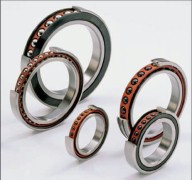 The ZSB small ball angular contact series spindle bearings allows machine tools to operate at higher running speeds (up to 20% more) while maintaining optimum work piece finish characteristics. The small ball feature of the ZSB series allows a greater number of balls to be used, increasing bearing stiffness, which leads to improved machining accuracy at higher speeds. Available with integral shields-reducing chance of bearings failure and prolonging lubricant life.
The ZSB small ball angular contact series spindle bearings allows machine tools to operate at higher running speeds (up to 20% more) while maintaining optimum work piece finish characteristics. The small ball feature of the ZSB series allows a greater number of balls to be used, increasing bearing stiffness, which leads to improved machining accuracy at higher speeds. Available with integral shields-reducing chance of bearings failure and prolonging lubricant life.
Ceramic Hybrid Bearings
Use of ceramic (silicon nitride) balls in place of steel balls can radically improve bearing performance several ways.
- Ceramic balls are 60% lighter than steel balls and their surface finish is almost perfectly smooth, they exhibit vibration levels two to seven times lower than conventional steel ball bearings.
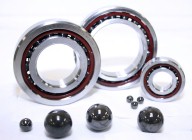 Ceramic balls drastically reduce the predominant cause of surface wear in conventional bearings (metal rings/metal balls). In conventional bearings, microscopic surface asperities on balls and races will "cold weld" or stick together even under normal lubrication and load conditions. Since ceramic balls will not cold weld to steel rings, wear is dramatically reduced.
Ceramic balls drastically reduce the predominant cause of surface wear in conventional bearings (metal rings/metal balls). In conventional bearings, microscopic surface asperities on balls and races will "cold weld" or stick together even under normal lubrication and load conditions. Since ceramic balls will not cold weld to steel rings, wear is dramatically reduced.- Ceramic hybrids can boost running speeds by 40% to 50%.
- Ceramic hybrids run significantly cooler than standard steel ball bearings.
- Lower operating temperatures help extend lube life.
- Ceramic hybrids will out last steel ball bearings up to five times.
- Ceramic hybrids have higher rigidity characteristics
- Ceramic hybrids are quieter running
Full Complement Bearings
Full complement ball bearings capitalise on the space usually occupied by the ball retainer, as removing the retainer enables additional balls to be fitted. This increase in ball complement allows for significant increases in bearing capacity in either axial or radial directions. Barden offers both deep groove and angular contact full complement bearings
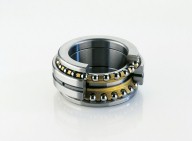 Double Direction Angular Contact Thrust Ball Bearings & Cylindrical Roller Ball Bearings
Double Direction Angular Contact Thrust Ball Bearings & Cylindrical Roller Ball Bearings
Double direction angular contact thrust ball bearings achieve a very high level of rigidity through their internal design and preload. Double direction angular contact thrust ball bearings series 2344-2347 should be used in combination with cylindrical roller bearings because they carry only thrust loads. Use of a cylindrical roller bearing in combination with a double row cylindrical roller bearing offers the advantage of supporting both axial and radial forces separately. Double direction angular contact thrust ball bearings with 60° contact angle are well suited for  applications requiring high axial stiffness. Double direction angular contact thrust ball bearings with 60° contact angle are well suited for applications requiring high axial stiffness.
applications requiring high axial stiffness. Double direction angular contact thrust ball bearings with 60° contact angle are well suited for applications requiring high axial stiffness.
Double row cylindrical roller bearings have a high load carrying capacity because of the high number of cylindrical rollers in each row, and the exclusive optimized roller crown profile which results in the best load distribution. The cage is of solid brass construction, making this bearing suitable for rugged applications. They are particularly suited for the demands of turning spindles. Available with ceramic rollers for higher speeds.

Custom Bearings and Designs
Barden's design engineers work closely with customers to develop unique bearing solutions with specialised features to meet application requirements and solve functional problems. Barden's innovations in special bearings range from nearly standard bearings with slightly modified dimensions to intricate assemblies which integrate the bearing function into a complete mechanism. In many cases, the overall cost of equipment can be reduced by incorporating special or customised bearings. Hybrid bearings (with ceramic balls) in particular save costs by improving performance. For applications such as aerospace bearings, mating components can be integrated into the bearing, for example mounting flanges, gear teeth, spring carriers and integral O ring grooves. The performance and installation benefits to be gained from using custom-designed bearings include:
- Improved assembly reliability
- Enhanced rigidity or stability of the system
- Better location control through proper bearing orientation
- Reduction in handling operations and contamination
- Improved alignment of the rotating assembly
- Weight reduction
- Improved resistance to temperature extremes
- Reduction in tolerance stack up
Bearing Cages

In any application proper attention to cage design and materials selection is essential to ensure reliable and long-term bearing performance. The role of cages, or separators as they are sometimes known, covers:
- They space the rolling elements apart equally and help lubricant distribution within the bearing.
- Separating the elements halves their running contact speed, allowing higher bearing speeds.
- They facilitate handling and installation of separable type bearings.
Since they may be required to accelerate rapidly, bearing cages should be lightweight and be manufactured from materials that have superior strength/weight ratios. Traditionally used brass or bronze cages have good wear characteristics but steel cages are offered which provide excellent service but at a lower cost. They are favoured in applications for harsh environmental conditions or where bearings are subject to very high levels of vibration or extremes of heat. Alternatively, in some price sensitive applications, cages manufactured from high performance plastics are preferred.
Other factors affecting cage design and selection:
- Low coefficient of friction with ball and race materials.
- Compatible expansion rate with ball/ring materials. low tendency to gall or wear.
- The ability to absorb lubricant.
- Dimensional and thermal stability.
- Suitable density.
- Adequate tensile strength.
- Creep resistance.
Bearing Closures

Bearing closures are available in two basic types - shields and seals. Both closure types are generally ordered as integral components of deep groove bearings.
Closures serve the same purposes with varying effectiveness - they exclude contamination, contain lubricants and protect the bearing from internal damage whilst being handled.
Closures are attached to the outer ring of the bearing. Seals are defined as closures which contact the inner ring, while shields clear the inner ring. Both are designed so that the stringent precision tolerances are not affected by their use.
Determining the proper closure for an application involves a trade-off, usually balancing sealing efficiency against speed capability and bearing torque. Shields do not raise bearing torque or limit speeds, but they do have low sealing efficiency. Seals are more efficient, but they may restrict operating speed and increase torque and temperature.
Another consideration in closure selection is air flow through the bearing. This is detrimental because it carries contamination into the bearing and dries out the lubricant. It is preferable to use seals if an air flow is present.
A number of types of closures are available from Barden. Please view this PDF for operating information.
Bearing Lubrication

One major contributing factor to a bearing's reliability is proper publication. Selecting the correct lubricant and maintaining it appropriately will significantly decrease the risk of premature bearing failure and running interference.
There are three main categories of bearing lubrication; oils, greases and solid dry film. Selection of the most appropriate lubricant is generally governed by the operating system and limitations of the bearing system.
View PDF with more information on the three types here
Selecting the right lubricant for a specific bearing and application can:
- Reduce friction and wear by supporting the load and separating the balls from the raceways.
- Minimise cage wear.
- Prevent oxidation/corrosion of the balls.
- Act as a barrier to contaminants.
- Conduct heat away from the bearing.
Recommended oil lubricants and their properties PDF can be viewed here.
Recommended grease lubricants and their properties PDF can be viewed here.
